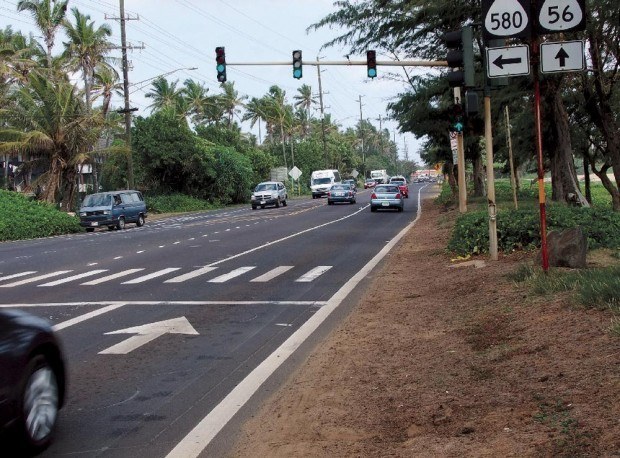PUHI — Expected to go out to bid soon is a project to widen Kuhio Highway to four lanes from Kuamo‘o Road at the Coco Palms Resort to the Kapa‘a bypass road, said Brennon Morioka, director of the state Department
PUHI — Expected to go out to bid soon is a project to widen Kuhio Highway to four lanes from Kuamo‘o Road at the Coco Palms Resort to the Kapa‘a bypass road, said Brennon Morioka, director of the state Department of Transportation.
This is in spite of the fact that the state’s own contracted archaeologist included in his report that the area from the Coco Palms fishponds to the ocean is thought to include many Native Hawaiian grave sites, said Alan Murakami, litigation director for the Native Hawaiian Legal Corporation.
A state deputy attorney general will ask the Kaua‘i court to dismiss the NHLC challenge (Wailua’s Waldeen Palmeira is plaintiff) to the project, as the state feels the challenge is “without merit,” Morioka said.
“We have gone beyond the call in terms of archaeological and consultation matters,” said Morioka, adding that it was the state’s suggestion to move the hearing on the lawsuit to Kaua‘i instead of having it heard on O‘ahu, where it was originally filed by NHLC.
“I’m saddened if he thinks there’s no merit to it,” Murakami said of the NHLC challenge.
It is the state’s responsibility “to deal with Native Hawaiian burials,” and laws mandate no development proceed in areas where burials are discovered until an approved burial treatment plan (to either re-inter or preserve in place) is approved, said Murakami.
The state DOT is not exempt from that law. “They don’t seem to appreciate that,” Murakami said.
“It irrefutably contains the area subject to widening,” said Murakami of the likely grave sites between the ocean and fishponds that old documents and state archaeological findings reveal.
The state must not take part in “destruction and desecration of burial sites,” Murakami said.
It is the state’s responsibility to “protect burials from disturbance,” and cultural descendants have a say as well, said Murakami.
The state did conduct an environmental assessment (EA) associated with the planned highway widening, and issued a finding of no significant impact.
Murakami said in his court filing that the state is mandated by state law to conduct a more-in-depth environmental impact statement (EIS) for the project, and gain approval from the Kaua‘i Ni‘ihau Island Burial Council for a burial treatment plan, before the project may proceed.
The state Department of Land and Natural Resources failed to fulfill its responsibilities to identify and protect known burial sites, and the DOT, DLNR and other defendants failed also to investigate and protect customary and traditional Native Hawaiian practices, Murakami’s court filing states.
At the scheduled April 13 hearing before 5th Circuit Judge Kathleen Watanabe, Murakami or his NHLC representative will ask the judge to grant a preliminary injunction prohibiting the project from taking place until burial sites are identified and protected, or grant a permanent injunction “as a matter of law,” Murakami said.
The project bid opening is tentatively set for early summer, and a combination of federal funds available both through the Federal Highways Administration and the economic stimulus law will fund the project, estimated to cost around $34 million, said Morioka when he was on Kaua‘i to participate in the blessing and groundbreaking ceremonies for widening Kaumuali‘i Highway to four lanes from Lihu‘e to Puhi.
Around half the cost of the project will be to meet a federal requirement to underground all utility lines along the short stretch of highway (just over a half a mile) in order to comply with U.S. Fish and Wildlife Service requirements against taking of endangered Newell’s shearwater seabirds (‘a‘o), Morioka said.
Construction is tentatively scheduled to begin in early fall, and take a year to 18 months to complete, said Morioka.
It is an opportune time for the project to go out to bid, as contractors are hungry and bids for projects statewide have averaged 30 percent to 40 percent under state-anticipated levels, Morioka said.
• Paul C. Curtis, staff writer, can be reached at 245-3681 (ext. 224) or pcurtis@kauaipubco.com.


